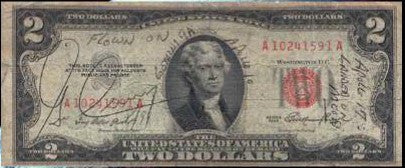Richard Jurek was a collector from an early age. Even as a child in the 1970s he was on the look-out for comic books, baseball cards, coins and stamps.
He was also particularly fascinated by space from an early age, but it's taken some time for that to become his main theme of collecting.
Initially he came to it through autographs, finding a list of celebrity addresses and writing to them requesting signatures. Remarkably his first was of a certain Neil Armstrong, who would be unlikely to respond in quite the same way if receiving such a request today.
(Armstrong's consistent refusal to sign has seen his autograph increase in value by nearly 1,000% since 2000 according to the PFC40 Autograph Index.)
 Apollo 15 space-flown $2 bill carried by Al Worden |
Jurek's shift into space-flown collectibles occurred around the turn of the millennium when he realised that it was possible to acquire items which astronauts had flown with them on missions.
He was particularly fascinated that many astronauts carried a $2 bill with them. Unlikely to be used to trade with aliens, the banknotes are light and follow the tradition of the 'short snorter' started by fighter pilots - a signed bill that buddy fighter pilot had to produce for the signer on request or buy them a drink (short).
Some of the highlights of Jurek's collection include:
A nice, fresh $2 bill carried on Apollo 15, which stayed with Al Worden orbiting the moon whilst David Scott and Jim Irwin explored the lunar surface. Unbelievably, although a fair number had been taken up with the crew they returned with few as many were left on the lunar surface by mistake!
 Gordon Cooper's 1917 $2 dollar bill |
Then there is a bill which was carried by Gordon Cooper on the last flight of the Mercury program, Faith 7. This is one of the oldest bills in the collection, printed in 1917 (years before Charles Lindbergh took his flight across the Atlantic in 1925). It is signed, as all the bills are.
One of the most poignant bills was one which Jurek acquired most recently, having been seeking it for some time. This is a series 1953 bill, with serial first taken into orbit by Gene Cernan on Gemini 9A as a favour to his father, who was in the habit of carrying this bill with him in his wallet for good luck.
 Gene Cernan multi space-flown $2 bill |
Sadly, Cernan's father died in January 1967, before his son could return the bill to him. In tribute to his father, Gene later flew the bill into lunar orbit on Apollo 10, coming within just 8.4 miles of landing on the lunar surface.
He also took it with him on the historic Apollo 17 mission, the last lunar landing of the Apollo program - and the bill made its way to the lunar surface, travelling with Gene and Harrison Schmitt in the spacecraft Antares to the Taurus Littrow Valley.
All these $2 bills and more are available to view now in the online Jefferson Space Museum, which Jurek created to celebrate the unlikely space-flight career of President Thomas Jefferson on all those $2 bills.






